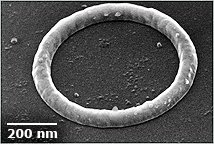Oct 15 2009
Physicists at Yale University have made the first definitive measurements of "persistent current," a small but perpetual electric current that flows naturally through tiny rings of metal wire even without an external power source.
 Harris made the first definitive measurement of an electric current that flows continuously in tiny, but ordinary, metal rings. (Photo: Jack Harris/Yale University)
Harris made the first definitive measurement of an electric current that flows continuously in tiny, but ordinary, metal rings. (Photo: Jack Harris/Yale University)
The team used nanoscale cantilevers, an entirely novel approach, to indirectly measure the current through changes in the magnetic force it produces as it flows through the ring. "They're essentially little floppy diving boards with the rings sitting on top," said team leader Jack Harris, associate professor of physics and applied physics at Yale. The findings appear in the October 9 issue of Science.
The counterintuitive current is the result of a quantum mechanical effect that influences how electrons travel through metals, and arises from the same kind of motion that allows the electrons inside an atom to orbit the nucleus forever. "These are ordinary, non-superconducting metal rings, which we typically think of as resistors," Harris said. "Yet these currents will flow forever, even in the absence of an applied voltage."
Although persistent current was first theorized decades ago, it is so faint and sensitive to its environment that physicists were unable to accurately measure it until now. It is not possible to measure the current with a traditional ammeter because it only flows within the tiny metal rings, which are about the same size as the wires used on computer chips.
Past experiments tried to indirectly measure persistent current via the magnetic field it produces (any current passing through a metal wire produces a magnetic field). They used extremely sensitive magnetometers known as superconducting quantum interference devices, or SQUIDs, but the results were inconsistent and even contradictory.
"SQUIDs had long been established as the tool used to measure extremely weak magnetic fields. It was extremely optimistic for us to think that a mechanical device could be more sensitive than a SQUID," Harris said.
The team used the cantilevers to detect changes in the magnetic field produced by the current as it changed direction in the aluminum rings. This new experimental setup allowed the team to make measurements a full order of magnitude more precise than any previous attempts. They also measured the persistent current over a wider range of temperature, ring size and magnetic field than ever before.
"These measurements could tell us something about how electrons behave in metals," Harris said, adding that the findings could lead to a better understanding of how qubits, used in quantum computing, are affected by their environment, as well as which metals could potentially be used as superconductors.
Authors of the paper include Ania Bleszynski-Jayich, William Shanks, Bruno Peaudecerf, Eran Ginossar, Leonid Glazman and Jack Harris (all of Yale University) and Felix von Oppen (Freie Universität Berlin).